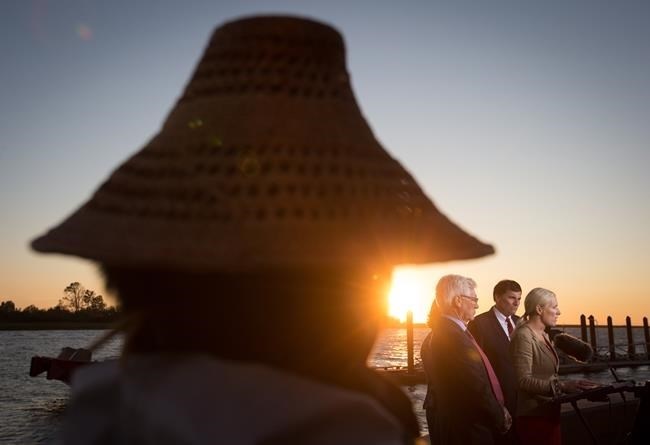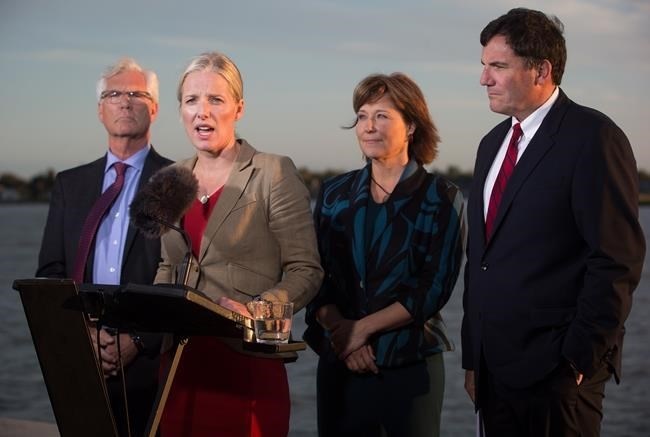
Christine Smith-Martin, front left, of the Tsimshian First Nation, listens as Catherine McKenna, far right, Minister of Environment and Climate Change, speaks while flanked by Dominic LeBlanc, second right, Minister of Fisheries, Oceans and the Canadian Coast Guard, and Jim Carr, Minister of Natural Resources, after the federal government announced approval of the Pacific NorthWest LNG project, at the Sea Island Coast Guard Base, in Richmond, B.C., on Tuesday September 27, 2016.
Image Credit: THE CANADIAN PRESS/Darryl Dyck
September 28, 2016 - 10:59 AM
RICHMOND, B.C. - Federal cabinet has conditionally approved the $36-billion Pacific NorthWest liquefied natural gas project.
Here are five things to know about the proposed project:
The Players:
Petronas, the Malaysian state-owned oil and gas giant, is leading the development. It has a 62 per cent stake in both the LNG processing facility on Lelu Island and the natural gas reserves in northeastern B.C. that would feed into it. Other partners include Sinopec with a 15 per cent stake, JAPEX and the Indian Oil Corp. with 10 per cent each, and PetroleumBRUNEI with three per cent.
The Product:
LNG is produced by cooling natural gas (consisting mostly of methane) to minus 162 degrees Celsius in order to make it a liquid. LNG takes up 1/600th of the space that it takes up in its gaseous state. The export facility would take in up to 3.2 billion cubic feet of natural gas per day and produce up to 19.2 million tonnes of LNG a year.
The Environmental Impact:
The draft environmental report released in February estimated that the LNG facility would result in the equivalent of 5.3 million tonnes of carbon dioxide being released a year. That would add 8.5 per cent to B.C.'s total emissions. Upstream emissions, including the gathering of the natural gas, are estimated to add the equivalent of 6.5 million to 8.7 million more tonnes of CO2.
State of the Industry:
A glut of global LNG projects have led to a drop in prices and prospects for LNG as well. The Shell-led LNG Canada project, which would have been built near Kitimat, B.C., was indefinitely delayed in July. AltaGas Ltd. also shelved its smaller Douglas Channel LNG project in February.
The Costs:
The entire Pacific NorthWest LNG project is estimated to cost $36 billion. That includes about $11 billion for the export terminal, $6.5 billion in pipelines, the $5.5 billion Petronas spent buying Progress Energy, and the roughly $2 billion a year the consortium would spend on drilling and production of natural gas to get the project fully operational.

Catherine McKenna, second left, Minister of Environment and Climate Change, speaks while flanked by Jim Carr, from left to right, Minister of Natural Resources, British Columbia Premier Christy Clark and Dominic LeBlanc, Minister of Fisheries, Oceans and the Canadian Coast Guard, after the federal government announced approval of the Pacific NorthWest LNG project, at the Sea Island Coast Guard Base, in Richmond, B.C., on Tuesday September 27, 2016.
Image Credit: THE CANADIAN PRESS/Darryl Dyck
Here is a timeline for the proposed Pacific NorthWest LNG project:
Feb. 19, 2013: Pacific NorthWest LNG submits its project description to the Canadian Environmental Assessment Agency.
April 29, 2013: Japan Petroleum Exploration Co. Ltd. agrees to buy 10 per cent of the liquefied natural gas that would be produced from Pacific NorthWest LNG over at least 20 years. This marks the first secure buyer for the project's LNG.
July 5, 2013: Pacific NorthWest LNG applies to the National Energy Board for a licence to export up to 19.68 million tonnes of LNG annually for 25 years, beginning in 2019.
Dec. 16, 2013: The NEB grants Pacific NorthWest LNG a licence to export up to 22.2 million tonnes of LNG annually for 25 years.
Feb. 28, 2014: Pacific NorthWest LNG submits its environmental impact statement to the Canadian Environmental Assessment Agency.
March 26, 2014: The federal government approves Pacific NorthWest LNG's export licence.
June 11, 2015: In its final investment decision, Pacific NorthWest LNG announces it will proceed with the project as long as it satisfies two conditions: approval of a project development agreement by the B.C. legislature and clearing the federal environmental assessment review process.
July 21, 2015: The B.C. government passes legislation that ratifies a project development agreement with Pacific NorthWest LNG.
March 21, 2016: The federal government grants the Canadian Environmental Assessment Agency more time to review the project.
Sept, 27, 2016: The Trudeau government gives conditional approval to the project.
News from © The Canadian Press , 2016